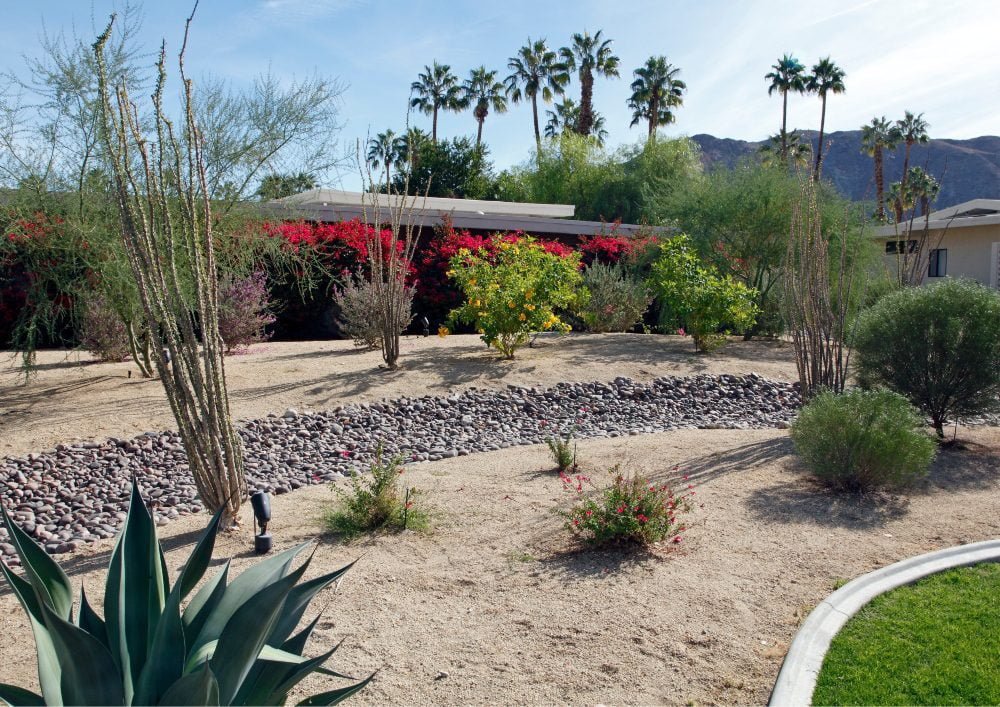
Xeriscaping 101: A Sustainable Oasis in Your Yard
In the current era, where the conservation of water is gaining significance, xeriscaping stands out as a symbol of sustainability for homeowners looking to blend aesthetics with eco-conscious living. Derived from the Greek word “xeros,” which means dry, this landscaping practice isn’t merely about substituting your lawn with cacti and succulents but a comprehensive approach that takes into account water conservation, soil enhancement, and strategic plant selection.
In this guide, we’ll delve into the principles of sustainable landscaping, provide hands-on tips, and guide you through the process of turning your yard into a water-efficient paradise.
Table of Contents
ToggleUnderstanding Xeriscaping
At its core, xeriscaping is a strategy to create landscapes that are not only visually appealing but also resilient and environmentally responsible. The technique is built on three fundamental principles: soil improvement, careful plant selection, and water conservation.
To truly understand it, consider it as an art form rather than a set of rigid rules. While water preservation is essential, the goal is not to eliminate water usage completely but to optimize it. This means designing landscapes that adapt to the local climate and minimize the need for excessive irrigation.
Assessing Your Yard
Before deciding to make some changes in your existing yard take a good look at your surroundings. Conduct a water check to identify areas with high water consumption. Observe sunlight patterns, shade distribution, and wind flows in your yard. This analysis will serve as the foundation for making informed decisions during the process.
For instance, if you notice a specific area consistently receives more sunlight than others, consider placing drought-tolerant plants that thrive in such conditions.
Soil Improvement
Healthy soil is essential for xeriscaping success. To improve water retention and drainage, enrich it with organic matter such as compost. In clay-rich soils, for example, adding organic matter helps break up the soil structure, allowing water to permeate more effectively.
Incorporate materials like perlite or vermiculite, strategically chosen to address specific soil needs. These amendments play a crucial role in improving drainage in heavy soils while simultaneously enhancing water retention in sandy soils.
Mulching is another powerful tool in the xeriscaper’s kit. Apply a layer of mulch around plants to reduce evaporation, it suppresses weed growth and regulates soil temperature. In regions with hot summers wood chips or straw can significantly reduce water loss from the soil surface.
Drought-Tolerant Plant Selection
It’s crucial to select the right plants. Look for native or adapted species that thrive in your region’s climate.
In the Southwestern United States, for example, native plants like agave, lucca, and penstemon are not only drought-tolerant but also contribute to the region’s unique aesthetic.
In the Pacific Northwest, incorporating native plants like Oregon grape and sword fern reduces water requirements and also attracts local wildlife, fostering biodiversity.
In areas with sweltering hot summers, in order to have a green and healthy lawn, you should plant grasses that can thrive in such harsh conditions with minimal work on your part. Drought-tolerant TifTuf Bermuda grass is a highly resilient sort of grass, and it’s an excellent choice for anyone looking to reduce water consumption.
Group plants with similar water needs together to create efficient irrigation zones. This grouping strategy helps tailor your watering schedule to the specific requirements of each zone, maximizing water efficiency.
Water-Efficient Design
Efficient irrigation lies at the heart of this water-conserving strategy. Drip irrigation systems and rainwater harvesting are techniques to ensure water is utilized optimally. For instance, by installing a drip irrigation system with a timer water can be precisely delivered to the base of plants, minimizing wastage through evaporation.
When planning your design, aim to minimize water runoff by strategically placing plants and incorporating permeable surfaces like gravel or pavers for paths and driveways. Rainwater harvesting can be a game-changer in drought-prone areas, allowing you to collect and store rainwater for later use in your garden.
Optimize water usage by also considering smart irrigation controllers. These devices adjust watering schedules based on weather conditions, soil moisture levels, and plant needs. They can significantly reduce water consumption while keeping your garden thriving.
Develop a watering schedule tailored to the specific water requirements of your plants. Differentiate between established and newly planted vegetation, adjusting the frequency and watering duration accordingly. Make sure to also consider seasonal variations in weather patterns when fine-tuning your irrigation plan.
Incorporating Hardscape Elements
Elevate your yard’s appeal and functionality by adding hardscape elements such as gravel pathways, decorative rocks, and stone accents. These additions enhance the visual aesthetics and play a crucial role in water efficiency and environmental resilience.
Strategically placed hardscape features minimize the areas requiring regular watering, contributing to the principles of xeriscaping. Beyond visual appeal, hardscaping actively addresses water drainage concerns, preventing soil erosion and safeguarding the structural integrity of your landscape.
Maintenance Tips
Regularly check irrigation systems to ensure they are functioning efficiently, and adjust them seasonally based on water needs.
Mulching is essential to retain soil moisture and suppress weeds, so replenish mulch as needed, especially before hotter months. Use natural weed suppressants to help keep your garden free from unwanted vegetation. Dealing with weeds early prevents them from competing with your drought-resistant plants for water and nutrients.
Regularly prune and shape your plants to help maintain the desired appearance while promoting their health. Remove dead or diseased branches, and shape plants to encourage proper growth patterns. This reduces extensive maintenance tasks later on.
Periodically inspect for pests and diseases and address issues promptly to prevent them from spreading. Consider utilizing rain barrels to collect and store rainwater for supplemental irrigation during dry spells.
Final Words
In embracing this strategy, you’re not just adopting a landscaping trend; you’re making a sustainable lifestyle choice that benefits both you and the environment. By incorporating water-efficient design, drought-tolerant plants, soil improvement, and low-maintenance practices, your yard can become a thriving haven that conserves water and supports biodiversity.
Lynn Place is Vice President of Marketing for SolvChem Custom Packaging Division. She has 30 years of professional experience in the manufacturing industry and specializes in consumer packaged goods, new product development and strategic planning.






